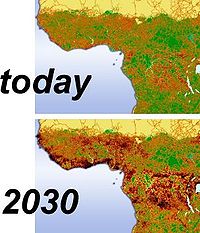
Photo from wikipedia
Abstract Land-use intensification is a major threat to arthropods across agricultural landscapes. To mitigate these negative effects through appropriate landscape management, it is necessary to understand how entire species communities… Click to show full abstract
Abstract Land-use intensification is a major threat to arthropods across agricultural landscapes. To mitigate these negative effects through appropriate landscape management, it is necessary to understand how entire species communities respond to land-use at the landscape scale. We performed a whole-landscape sampling of spiders in 300 habitat patches across 15 landscapes and built species-habitat networks to evaluate the impact of compositional and configurational simplification on network modularity and habitat specialisation. Within each landscape mosaic, spiders showed a high degree of habitat selectivity, i.e. patches of the same habitat type tended to cluster into modules that rarely interacted with each other. Although spiders are expected to disperse between habitat patches more often when landscapes are fragmented, their high modularity and habitat selectivity were not influenced by edge density. However, modularity was the highest at intermediate cover of semi-natural habitats, probably due to the simultaneous presence of multiple habitats with sufficient area to support the associated specialist species. Despite the high habitat selectivity, perennial crops and meadows seemed to play a central role in connecting different habitat modules across the landscapes. On the contrary, forest and hedgerows hosted very distinct species communities that did not occur outside woody habitats. Encouraging the spill-over of spiders from semi-natural habitats to crops to enhance biological control might be more effective for the better-connected permanent crops, while for annual crops it would be more effective to improve local field quality for crop specialists or to introduce open semi-natural habitats such as meadows.
Journal Title: Biological Conservation
Year Published: 2019
Link to full text (if available)
Share on Social Media: Sign Up to like & get
recommendations!